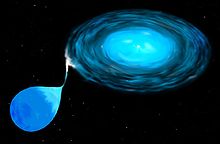ZTF J1813+4251
| Observation data Epoch J2016.0 Equinox J2000.0 | |
|---|---|
| Constellation | Hercules |
| Right ascension | 18h 13m 11.13s[1] |
| Declination | 42° 51′ 50.4″[1] |
| Apparent magnitude (V) | 18.72[2] |
| Astrometry | |
| Radial velocity (Rv) | 461.3[1] km/s |
| Proper motion (μ) | RA: −12.317[3] mas/yr Dec.: −2.656[3] mas/yr |
| Parallax (π) | 1.1975 ± 0.1551 mas[3] |
| Distance | approx. 2,700 ly (approx. 800 pc) |
| Orbit[1] | |
| Period (P) | 51.16 min |
| Semi-major axis (a) | 0.4 R☉ |
| Eccentricity (e) | 0 (fixed) |
| Inclination (i) | 78.80° |
| Semi-amplitude (K2) (secondary) | 461.3 km/s |
| Details[1] | |
| White Dwarf | |
| Mass | 0.562±0.015 M☉ |
| Radius | 0.01374±0.00023 R☉ |
| Surface gravity (log g) | 7.9 cgs |
| Temperature | 12600±500 K |
| Donor | |
| Mass | 0.1185±0.0067 M☉ |
| Radius | 0.1017±0.0019 R☉ |
| Surface gravity (log g) | 5.43 cgs |
| Temperature | 6000±80 K |
| Rotational velocity (v sin i) | 145 km/s |
| Other designations | |
| Database references | |
| SIMBAD | data |
ZTF J1813+4251 is a binary star system including a star and white dwarf, co-orbiting every 51 minutes, about 3,000 light years away in the constellation of Hercules. It is considered a cataclysmic variable with the white dwarf pulling outer layers of hydrogen from the star onto itself. It has the shortest orbital period of all hydrogen-rich cataclysmic variable stars known. It is predicted that the orbital period will reach a minimum of 18 minutes within 75 million years as the system evolves.[1]

It was identified in 2022 by Kevin Burdge of MIT using a computer algorithm that searched over 1,000 images from the Zwicky Transient Facility, identifying stars that had brightness variability periods around one hour.
References[edit]
- ^ a b c d e f g Kevin B. Burdge; Kareem El-Badry; Thomas R. Marsh; Saul Rappaport; Warren R. Brown; Ilaria Caiazzo; Deepto Chakrabarty; V. S. Dhillon; Jim Fuller; Boris T. Gänsicke; Matthew J. Graham; Erin Kara; S. R. Kulkarni; S. P. Littlefair; Przemek Mróz; Pablo Rodríguez-Gil; Jan van Roestel; Robert A. Simcoe; Eric C. Bellm; Andrew J. Drake; Richard G. Dekany; Steven L. Groom; Russ R. Laher; Frank J. Masci; Reed Riddle; Roger M. Smith; Thomas A. Prince (5 October 2022). "A dense 0.1-solar-mass star in a 51-minute-orbital-period eclipsing binary". Nature. 610 (7932): 467–471. arXiv:2210.01809. Bibcode:2022Natur.610..467B. doi:10.1038/S41586-022-05195-X. ISSN 1476-4687. Wikidata Q114815846.
- ^ Lasker, Barry M.; et al. (August 2008). "The Second-Generation Guide Star Catalog: Description and Properties". The Astronomical Journal. 136 (2): 735–766. arXiv:0807.2522. Bibcode:2008AJ....136..735L. doi:10.1088/0004-6256/136/2/735. S2CID 17641056.
- ^ a b c Vallenari, A.; et al. (Gaia collaboration) (2023). "Gaia Data Release 3. Summary of the content and survey properties". Astronomy and Astrophysics. 674: A1. arXiv:2208.00211. Bibcode:2023A&A...674A...1G. doi:10.1051/0004-6361/202243940. S2CID 244398875. Gaia DR3 record for this source at VizieR.
External links[edit]
- Astronomers find a “cataclysmic” pair of stars with the shortest orbit yet
- Scientists spot ‘cataclysmic star pair’ whirring around each other in spectacular dance
- "Cataclysmic" Pair Of Stars With Shortest Known Orbit Discovered
- Two Stars Orbiting Each Other Every 51 Minutes. This Can’t End Well



